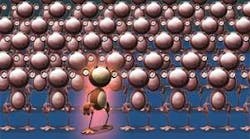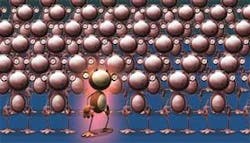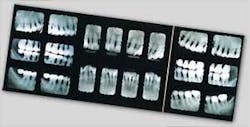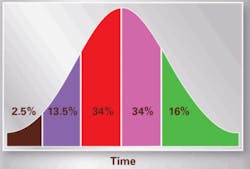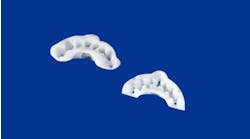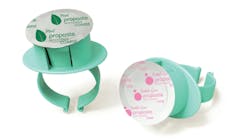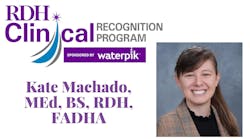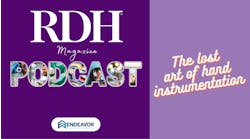The profession is shifting from a disease-based repair model of health to an oral medicine molecular model. When will you join up?
by Patti DiGangi, RDH
As the World Turns, one of the longest-running American soap operas, debuted on April 2, 1956, about the same time as the ultrasonic scaler. Soap opera characters have been killed, gotten married and divorced several times, altered careers and been played by different actors. This show has changed but not gone through a paradigm shift. Just making changes does not equate to a paradigm shift. Many changes in dental hygiene aren’t true paradigm shifts either. Dental hygiene is still working on true change in our conceptual worldview and the behaviors that go with those changes. Oral infections have systemic implications, and systemic conditions have a reciprocal impact on oral health. These facts are pushing us into a new era. The breakthrough is in our understanding of periodontal disease. This evolution is the central role of hygienists in disease prevention and management.
Disease management, an increasingly popular approach in the health insurance industry, is spreading to dentistry. Delta Dental Plan of Massachusetts recently launched a disease management program that’s a shift from dentistry’s traditional focus on repair to one on prevention. It’s about time! Maybe we finally reached “Hundredth Monkey” (see sidebar). The Hundredth Monkey story is based on research with monkeys on a northern Japanese island. The idea is that when enough people in a population adopt a new idea or behavior, an ideological breakthrough occurs that allows this new awareness to be communicated directly from mind to mind without the connection of external experience. Then all individuals in the population spontaneously adopt it.
The Hundredth Monkey story is a metaphor for a paradigm shift. We are shifting from a disease-based repair model of health to an oral medicine molecular model. This shift is not evidenced by the technique, materials or systems used; the shift is seen by redefined goals of care.
In the 1950s and 1960s, the etiology of periodontal disease was thought to be calculus and toxins embedded in the roots of teeth. In the mid-1980s, a shift in the periodontal paradigm occurred with the understanding that microorganisms in biofilms cause periodontal disease. The extent and severity of breakdown depends on how the host responds to the extent and virulence of the microbial burden. The important role hygienists play is the recognition of each individual’s immune system status in addition to the disruption of biofilms. Biofilms are well organized, cooperating communities of microorganisms that are difficult to disrupt because as biofilms develop, a matrix surrounds the micro-colonies and acts as a protective barrier. Ultrasonics offer the best option for thorough disruption of biofilms.
In 1992, Irene Woodall said, “Ultrasonic instrumentation is now the first choice over hand instrumentation for most patients.” Ultrasonic scaling actions include mechanical vibration, cavitation and irrigation. Mechanical vibration is produced when the device’s energy is converted to high-frequency electrical sound waves, creating rapid vibration that shatters calculus. The cavitation effect is created when the vibrating tip is cooled by water, creating minute bubbles that collapse and release energy. Cavitation does not remove hard deposit, but plays a more important role by destroying bacteria and removing endotoxins. The irrigation from the tip can penetrate to the base of the pocket, creating a flushing effect. The oscillation of the tip causes hydrodynamic waves, and it is believed the acoustic turbulence disrupts the biofilm. This effective method for the disruption of biofilms can lead to improved periodontal health. Our goals must shift from mere calculus and plaque removal to attaining a root surface that is biologically compatible with the reformation of health and functional attachment, and to convert pathogenic flora to healthy flora. Biofilm disruption can help create an oral environment favorable for total body health.
Many dental hygiene professionals have embraced the use of ultrasonics, yet myths still prevail. In his 1995 book, Diffusion of Innovations, Everett Rogers examined the adoption level of innovations. He noted adoption could be graphed on a bell curve as shown in Box 1. The most left 2.5 percent were labeled innovators. The next 13.5 percent were tagged early adopters. The left center 34 percent were the early majority, with the right center 34 percent the late majority. These were followed by the last 16 percent, which were identified as laggards.
Most of us are in the center section. Early adopters are considered opinion leaders in the community with respect to change and innovation. The timely words of many opinion leaders in regard to ultrasonics are shown in the related sidebar. In addition, four key opinion leaders were interviewed about ultrasonics and its myths.
Best Way To Protect Your Body and Theirs
In 1997, Cher Thomas, RDH, BS, was diagnosed with acute renal failure due to ANCA+ vasculitis, an autoimmune disorder. After four months of high doses of prednisone and oral chemotherapy drugs, she started peritoneal dialysis. She eventually received a kidney from her brother. Her goal is to educate medical and dental professionals about the oral health for their patients living with Chronic Kidney Disease (CKD) and Organ Transplantation. These patients are unique in the dental office. End stage organ disease is usually secondary to a systemic illness, making education regarding standard dental treatment essential. Cher is passionate about the use of ultrasonics, and believes not using ultrasonics is malpractice. She used ultrasonics right out of school, and quickly realized the value for herself and her patients.
Long before her kidney disease, Cher knew she must think about her own body. She said, “At the end of our careers, there is no gold medal given for beating up our own body to help others.” She believes in using ultrasonics on every patient, every time.
Learn To Use Every Option
Renee Marchant-Turner, RDH, is a clinical hygienist of 27 years with clinical experience in general, periodontal and public health settings. Her expertise and hands-on programs are on microultrasonic techniques, using magnetorestrictive and piezo technology. Renee believes ultrasonics should become clinicians’ primary instrument, and hand scalers secondary. In her lectures she says, “Excellent ultrasonic outcomes are a product of half technique and half quality equipment. You can’t expect to obtain a good result, with patient comfort, without that combination.”
She believes the best way to learn ultrasonics is through hands-on workshops. The goal of periodontal debridement is not to recontour the root surfaces, but simply disrupt and remove the endotoxins and hard deposits. This can best be accomplished with ultrasonics, which are state-of-the-art, not just an option. Renee debunks the myth of damage caused by ultrasonics by offering research with a dramatic photo (Figure 1) that compares different types of instrumentation. After 40 seconds of ultrasonic instrumentation, 11.6 microns of root surface are removed. In comparison, after 40 seconds of hand instruments, 108.9 microns of root surface are removed. Renee said she will never give up hand scalers, even though she uses them for less than 10 percent of her appointment time. She wants to have every option available, including lasers. She believes lasers are an incredible option care that can take hygienists to a higher level. Whether using manual instruments, ultrasonics, or lasers, one must understand the goal of care.
Learn By Relying On Them
Understanding the goal of care was the same theme expressed by Beth Thompson, RDH, BS. Beth is a multifaceted professional with expertise as a clinician and educator. She is co-founder of CareerFusion (www.careerfusion.net) (formerly CareerFlow), the first and only resource for dental hygiene career advancement. Beth would like to see hygienists focus more on the long-term results of treatment. Hygienists think of the end point of treatment as the end of the appointment, yet the focus should be on how to restore a patient to health and preserve the most tooth structure. Even lesser skilled dental hygienists can do more good and less harm with ultrasonics. We don’t learn to use ultrasonics properly unless we learn to rely on them. If we constantly fall back on manual instruments, we won’t learn.
Beth said learning ultrasonics is like learning to use a new Gracey. We can think of ultrasonics like a “motorized” manual instrument. She also said that endoscopy has given us an opportunity to see and be more definitive in our care. The concern is that hygienists will continue to believe that periodontal disease is calculus-based. We now know that it is a host-response disease. There is evidence that calculus can remain in a pocket and the tissues can heal. The bacteria can remain in a pocket without evidence of active infection. We do not have to remove every speck of calculus to restore tissues to health. A glassy smooth root surface is not the ultimate goal of periodontal therapy. A biologically compatible result is the goal. Endoscopy has also helped us prove that calculus deposits cannot be removed as efficiently or thoroughly with hand instruments as with ultrasonics.
There’s Always A Learning Curve
Diane Brucato-Thomas, RDH, BS, EF, was an early adopter of endoscopy. She uses a “whole person” approach in periodontics and said that hygienists need to align the goal with what is done. Like many seasoned hygienists, her first experiences were using tunable ultrasonics for heavy debris removal, with hand scaler follow-up. Diane said learning ultrasonics takes practice. Exploring is still OK, but following the explorer with an ultrasonic rather than a hand instrument to remove the calculus can build skill and improve understanding of the goal. Diane learned expanded function training, which showed her that all SRP is not the same, and the intricacy and value of excellent technique with hand instruments.
Her eyes were opened further when she saw a video on perioscopy.* She was so excited by its possibilities that she purchased a unit, and has subsequently purchased a newer design ultrasonic. Microultrasonics cannot be beat for access with perioscopy to see what and where is being accessed, and successful removal. She found myths about scaling debunked by perioscopy. Unless working with perioscopy, she said, “We can’t know what we are truly accomplishing, or just as important, we don’t really know when to stop.”
Diane is also certified in the use of lasers, and as with any new technique, there is a learning curve. Professionals lag on change because they fear the unknown, are afraid of the expectations of others, and are concerned about rocking the boat. For many hygienists, change almost feels like an act of betrayal to instructors they hold on a pedestal. People also hold onto skills based on the time and money they invested in learning them. Diane’s bottom line is to know science and technology and use one’s brain.
Change Is Inevitable– Will You Be The Hundredth Monkey?
These individuals are driving the paradigm of change. We are shifting from a disease based repair model of health to an oral medicine molecular model. This shift is not evidenced by the technique, materials or systems used, but rather by redefined goals of care. Our goals are shifting to attaining root surfaces that are biologically compatible with maintenance and the reformation of health and functional attachment, and to converting pathogenic flora to flora that is compatible with health and an oral environment favorable for total body health. Biofilm disruption through routine use of ultrasonics is an important part of this equation.
Change is inevitable; it’s the only true constant. Yet change is difficult and we resist it.
Bill Landers, president of Oratec (www.oratec.net), said, “Sadly, it takes a long time for paradigm shifts to be fully accepted and integrated. A generation or more. Why so long? Most people find it impossible to let go of their old paradigms and mind-sets. Whatever they learned in their formative years ... sticks.
“Paradigms do change, but slowly, not so much because the new ideas replace old ones, but because the holders of the old ideas start dying off. There’s a gradual transition as the new generation grows up with the knowledge of both old and new paradigms and can choose one or the other without having to abandon the old for the new. Some psychologists think we are genetically programmed against radical change. Most organisms thrive in a homeostatic environment where everything is the same all the time. Change is risky, possibly lethal. Most species are change adverse.”
Change begins in the mind. What is perceived is subject to the limitations and distortions produced by our inherited and socially conditioned nature. Yet, we can change. Many are aware of the shift in the dental hygiene paradigm. Dental hygiene can reach the Hundredth Monkey phenomenon if just one more person tunes in. Will it be you? Our profession will be strengthened by your choices so that this awareness can be picked up by almost everyone!
*Author’s note: DentalView has been purchased by Perioscopy Incorporated, owned by periodontist John Y. Kwan, DDS. Perioscopy Incorporated will be providing support for those currently using the technology and those interested in learning and implementing perioscopy, as well as working to develop the next generation in periodontal endoscopic equipment. Call (510) 547-1300, or logon to www.peri-Eau.com.
Acknowledgements
Thank you to those that gave their time, energy and expertise for this article – Beth Thompson, RDH, BS, Cher Thomas, RDH, Diane Brucato-Thomas, RDH, EF, BS, Renee Turner, RDH, and Bill Landers.
About the Author
Patti DiGangi, RDH, BS, is a speaker, author, practicing dental hygiene clinician, and American Red Cross authorized provider of CPR and first aid training. She can be contacted through her Web site at www.pdigangi.com.
References
- Diogo S. “Evolutionary Hygiene” Dental Products.net. April 2004. Available at: http://www.dentalproducts.net/xml/display.asp?file=2354&bhcp=1 Accessed April 8, 2007
- Carlson L. “Pursuing cost savings in dental benefits” Benefitnews.com. Available at: http://www.benefitnews.com/pfv.cfm?id=6780. Accessed April 9, 2007
- de Jager P. “The Danger of the ‘Early Adopter’ Myth” 2005 Technobility.com. Available at: http://www.technobility.com/docs/article032.htm. Accessed April 9, 2007
- Ritz L, Hefti A, Rateitschak KH. An in vitro investigation on the loss of root substance in scaling with various instruments, J Clin Periodontol. 1991 Oct;18(9):643-7. Available at: http://www.ncbi.nlm.nih.gov/entrez/query.fcgi?cmd=Retrieve&db=PubMed&list_uids=1960232&dopt=Abstract. Accessed April 1, 2007
- Ryan D, et al. Effects of ultrasonic scaling and hand-activated scaling on tactile sensitivity in dental hygiene students, J Dent Hyg 2005. Abstract available at: http://www.ncbi.nlm.nih.gov/entrez/query.fcgi?cmd=Retrieve&db=PubMed&list_uids=16197758&dopt=Abstract. Accessed April 1, 2007.
- Caserin R. Pinto F. “Assessment of ultrasonic root surface scaling at different power settings, roughness evaluation.” Braz J Oral Sci. April-June 2006. Available at: libdigi.unicamp.br/document/?down=15092 Accessed April 2, 2007.
The Hundredth Monkey: A Story of Social Change
The Japanese monkey, Macaca Fuscata, had been observed in the wild for over 30 years. In 1952, on the island of Koshima, scientists were providing monkeys with sweet potatoes dropped in the sand. The monkeys liked the taste of the raw sweet potatoes, but they found the dirt unpleasant. An 18-month-old female named Imo solved the problem by washing the potatoes in a nearby stream, and she taught this trick to her mother. Her playmates also learned and taught their mothers. This cultural innovation was gradually picked up by various monkeys before the eyes of the scientists. Between 1952 and 1958, all the young monkeys learned to wash the sandy sweet potatoes to make them more palatable. Only the adults who imitated their children learned this social improvement. Other adults kept eating the dirty sweet potatoes.
Then something startling happened. In the autumn of 1958, a certain number of Koshima monkeys were washing sweet potatoes – the exact number is not known. Let us suppose that when the sun rose one morning there were 99 monkeys on Koshima Island who had learned to wash their sweet potatoes. Let’s further suppose that later that morning, the hundredth monkey learned to wash potatoes.
Then it happened! By that evening, almost everyone in the tribe was washing sweet potatoes before eating them. The added energy of this hundredth monkey somehow created an ideological breakthrough! But notice, a most surprising thing observed by these scientists was that the habit of washing sweet potatoes then jumped over the sea ... Colonies of monkeys on other islands and the mainland troop of monkeys at Takasakiyama began washing their sweet potatoes.
Thus, when a certain critical number achieves awareness, this new awareness can be communicated from mind to mind. Although the exact number may vary, this hundredth monkey phenomenon means that when only a limited number of people know a new way, it may remain the conscious property of these people. But there is a point when only one more person tunes into a new awareness, the field is strengthened so that this awareness is picked up by almost everyone!
From Keyes K Jr. The Hundredth Monkey. Indianapolis, IN: Vision Books; 1981.
Key Opinion Leaders Speaking About Ultrasonics
- “Products like ultrasonic scalers are tools that we have to employ on a different level. We’re moving away from the hand instruments because the ultrasonics are necessary to break up the biofilm that we now understand are the mechanism of active disease ... Periodontal therapy employs that technology; but I often go into practices where they’re using equipment from the 1960s – then you can’t really do the periodontal therapy. You need the modern equipment.” – Coleen Rutledge
- “In my opinion it would be difficult, if not impossible, for most clinicians to put their hand scalers aside completely, but the tables are turning as the evidence mounts in favor of an ultrasonic scaler as our primary weapon against biofilm-based dental disease. Ultrasonic scaling is not ‘Scaling for Dummies.’ It is a sophisticated technology that can help us provide superior clinical care while saving our bodies from the ravages of repetitive stress injuries.” – Anne Guignon, RDH, MPH
- “Powered instrumentation is proving safer and more efficient, and is certainly a time saver. Regardless of your personal preference, there is no doubt that powered instrumentation is here to stay. In fact, most dental hygiene clinical boards now permit the technology to be used during the examination. Though research has demonstrated equal or better results with this method over hand instrumentation, it is paramount for optimal results and client comfort that clinicians develop excellent technique and understand the basics behind the science.” – Kristy Bernie, RDH, BS
- “There is a profound change occurring in the use of ultrasonics to treat periodontal disease … forget what you learned in school. The ultrasonic scaler is your most potent weapon against periodontal disease. If you’re using your ultrasonic scaler as an adjunct to hand instruments, you’ve got it backwards.” – Larry Burnett, DDS
- “Today’s ultrasonic scaler is one of your most potent weapons in the war against periodontal disease. But you have to use proper technique, and proper ultrasonic technique has changed dramatically in the past few years.” – Jill S. Nield-Gehrig, RDH, MA
- “Ultrasonic instrumentation is not effective and can even be harmful if the clinician is not skilled in technique. An ultrasonic unit used correctly with the appropriate diameter tip is probably the most effective strategy in removing biofilm … ultrasonic instrumentation is an art.”– Sam B. Low, DDS, MS, MEd
- “Hygienists scraping, scraping, scraping with hand instruments. The paradigm changed in the early 1990s to support the ultrasonic as the instrument of choice for all dental hygiene procedures - recall and perio - for children and adults. The tips and techniques are efficient and well-tolerated by most patients.” – Linda Drevenstadt, RDH, MS
